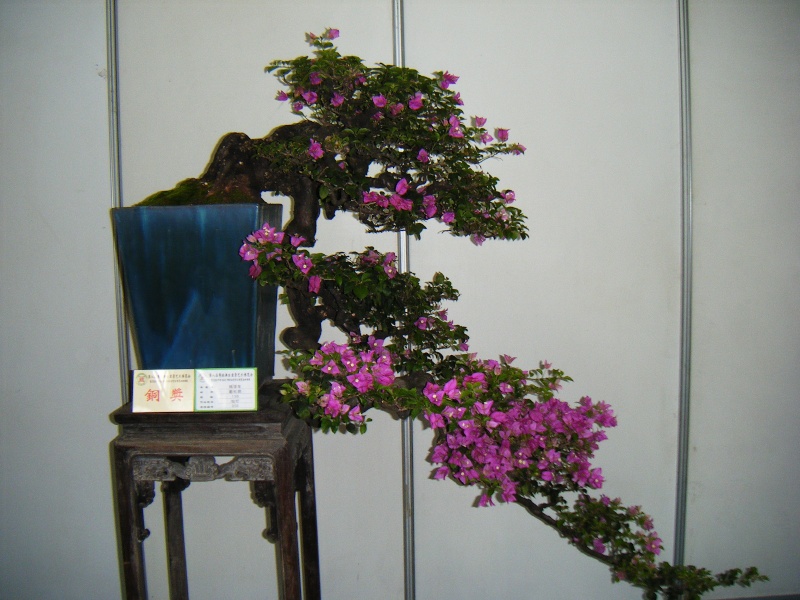Question on Hardiness - South China - and plants used for Bonsai
+2
Billy M. Rhodes
Khaimraj Seepersad
6 posters
Page 1 of 1
 Question on Hardiness - South China - and plants used for Bonsai
Question on Hardiness - South China - and plants used for Bonsai
Can anyone explain this, please.
These plants from China are used in Bonsai -
Fukien Tea,
Serissa
Ligustrum
Elm
Murraya p.
Podocarpus
Okay according to the map of China -
http://www.backyardgardener.com/zone/china.html
only a tiny section as China goes is listed as zone 11 - 40 deg.F and above [4.5 C and above ]
the rest is 30 to 40 deg.F and lower [ -1.1 and 4.4 deg.c ]
How come there are so few folk growing the above trees outdoors in the US or UK [ zones 8,or 9]
is it because no one has checked to see just where these trees really come from?
There doesn't seem to be any part of China in the Tropics ?
Just curious.
Khaimraj
* Do these shrubs / trees go dormant with shorter days and not cold ?
These plants from China are used in Bonsai -
Fukien Tea,
Serissa
Ligustrum
Elm
Murraya p.
Podocarpus
Okay according to the map of China -
http://www.backyardgardener.com/zone/china.html
only a tiny section as China goes is listed as zone 11 - 40 deg.F and above [4.5 C and above ]
the rest is 30 to 40 deg.F and lower [ -1.1 and 4.4 deg.c ]
How come there are so few folk growing the above trees outdoors in the US or UK [ zones 8,or 9]
is it because no one has checked to see just where these trees really come from?
There doesn't seem to be any part of China in the Tropics ?
Just curious.
Khaimraj
* Do these shrubs / trees go dormant with shorter days and not cold ?

Khaimraj Seepersad- Member
 Question on Hardiness - South China - and plants used for Bonsai
Question on Hardiness - South China - and plants used for Bonsai
Hello Khaimraj. Our Winter temps go a lot colder than that. -10 c is not unusual in Winter. Chinese Elm's seem to cope well outdoors all year round but the majority of your list are a no no. We have plenty of excellent trees that love our climate anyway  . Why struggle with those that don't?
. Why struggle with those that don't?
Guest- Guest
 Re: Question on Hardiness - South China - and plants used for Bonsai
Re: Question on Hardiness - South China - and plants used for Bonsai
Last edited by Billy M. Rhodes on Tue Feb 01, 2011 2:27 am; edited 1 time in total (Reason for editing : Unsure of species of tree in photo)

Billy M. Rhodes- Member
 Re: Question on Hardiness - South China - and plants used for Bonsai
Re: Question on Hardiness - South China - and plants used for Bonsai
Hey Khaimraj,
Of the plants you mention, ligustrum and elm aren't exactly tropical although they are happy here in zn 8b and much farther south. As a matter of fact, I've seen Chinese elms coming up from seed like weeds around mature trees. Ligustrums of a couple of species are widely planted as landscape shrubs, and L. chinensis has become an invasive weed. Podocarpus is a common landscape shrub here too. Fukien tea is considered tropical, and I've never tested its actual cold tolerance. People with Serissa are going to protect them in the winter just to be on the safe side, and Murraya isn't really available unless you head south into Florida. Okay, that's the north Gulf Coast report.
R
Of the plants you mention, ligustrum and elm aren't exactly tropical although they are happy here in zn 8b and much farther south. As a matter of fact, I've seen Chinese elms coming up from seed like weeds around mature trees. Ligustrums of a couple of species are widely planted as landscape shrubs, and L. chinensis has become an invasive weed. Podocarpus is a common landscape shrub here too. Fukien tea is considered tropical, and I've never tested its actual cold tolerance. People with Serissa are going to protect them in the winter just to be on the safe side, and Murraya isn't really available unless you head south into Florida. Okay, that's the north Gulf Coast report.
R

Russell Coker- Member
 Re: Question on Hardiness - South China - and plants used for Bonsai
Re: Question on Hardiness - South China - and plants used for Bonsai
Will, thanks for taking the time to respond. I would believe that the temperatures listed are done on an average, so China probably gets colder on certain days or weeks as well.
Know anyone growing any of these trees outdoors in winter ?
I remember visiting the UK nurseries that handled the exported Chinese trees, unheated structures with plastic covers, in late November when the temperature was already around 5-7 deg.c.
Billy, don't they come from a sub-tropical zone ? and I have seen them on-line as trees. Pretty picture.
Russell,
got any spare Fukien tea non-bonsai to test ?
I pretty much figure that all those listed trees, plus Sageretia are able to handle some snow. A friend in New Jersey, keeps his serissas, outdoors in the snow for winter.
It is obvious that some trees / shrubs can cross zones successfully - oranges - mandarins - as far as I know were not originally from the tropics [ stand to be corrected.]
Also noted was the Chinese exporting mangoes and a 1000 year old Banyan, so I guess some Ficus types can take some cold, other than the F.carica.
It would be so helpful, if the listings said plant x from this province, and not just South China.
Khaimraj
Know anyone growing any of these trees outdoors in winter ?
I remember visiting the UK nurseries that handled the exported Chinese trees, unheated structures with plastic covers, in late November when the temperature was already around 5-7 deg.c.
Billy, don't they come from a sub-tropical zone ? and I have seen them on-line as trees. Pretty picture.
Russell,
got any spare Fukien tea non-bonsai to test ?
I pretty much figure that all those listed trees, plus Sageretia are able to handle some snow. A friend in New Jersey, keeps his serissas, outdoors in the snow for winter.
It is obvious that some trees / shrubs can cross zones successfully - oranges - mandarins - as far as I know were not originally from the tropics [ stand to be corrected.]
Also noted was the Chinese exporting mangoes and a 1000 year old Banyan, so I guess some Ficus types can take some cold, other than the F.carica.
It would be so helpful, if the listings said plant x from this province, and not just South China.
Khaimraj

Khaimraj Seepersad- Member
 Re: Question on Hardiness - South China - and plants used for Bonsai
Re: Question on Hardiness - South China - and plants used for Bonsai
Khaimraj Seepersad wrote:It would be so helpful, if the listings said plant x from this province, and not just South China.
Khaimraj
I don't think that would tell you much. Found this little blurb about Yunnan Province, one of the most ecologically diverse areas of the world...
"Within these borders, Yunnan has a diverse topography that ranges from alpine mountain ranges to tropical rainforests and the greatest number of plant species in China (more than 18,000) as well as an incredible array of animals, including the Asian elephant and the protected Yunnan golden monkey. There is even a rainforest in the area known as Xishuangbanna where you will find many rare and endangered species of plants and animals."
To make matters worse, the Coastal Plain of the SE USA is pretty mountain free.

Russell Coker- Member
 Re: Question on Hardiness - South China - and plants used for Bonsai
Re: Question on Hardiness - South China - and plants used for Bonsai
Khaimraj Seepersad wrote:Can anyone explain this, please.
These plants from China are used in Bonsai -
Fukien Tea,
Serissa
Ligustrum
Elm
Murraya p.
Podocarpus
Okay according to the map of China -
http://www.backyardgardener.com/zone/china.html
only a tiny section as China goes is listed as zone 11 - 40 deg.F and above [4.5 C and above ]
the rest is 30 to 40 deg.F and lower [ -1.1 and 4.4 deg.c ]
I've never worked on Murrya or Fukian tea, but none of the others you list are true tropicals.
Serissa grows outdoors here as a hedge and border plant well into the colder parts of zone 8. Ligustrum -- depending on the species -- grows much farther north, L. sinensis which I grow thrives everywhere here in zone 7, though it gets semi deciduous in the ground and totally deciduous in pots. Elms, including Chinese elms grow much farther north then I am. Even Podocarpus grow fairly easily in zone 8 -- and I have one that is too big for me to move any more which is really struggling outdoors here (zone 7) this winter. It has survived (so far) temps of 10 degrees F. (I brought my smaller one inside).
We tend to lump a lot of exotic trees in with the tropicals. They may be tender, but they'e not truly tropical, in the sense of hothouse plants. Some, if they are native to areas between the Tropics of Cancer and Capricorn may grow at higher elevations.

JimLewis- Member
 Re: Question on Hardiness - South China - and plants used for Bonsai
Re: Question on Hardiness - South China - and plants used for Bonsai
Russell,
thanks for taking the time to research. I see Yunnan listed as averaging 8 to 17 deg.c in January which is already out of the Tropical temperatures for winter.
Plus the map direction that I left shows nothing unusual as averages go for comparison, to the US for example. I know that the UK may not go to low as say zone 7, but their top summer temperature isn;t
very high either, maybe a 30 deg.c once in a while for a short period of a day.
I get the funny feeling that a fukien tea drops it's leaves in cold weather and goes dormant.
Jim,
I am willing to bet you anything that comes from China, handles some form of winter, and the tender part comes in when you cross a zone. So if you look at the size of the zone 9 or zone 8 in China, a species [?] can live happily for hundreds of miles.
Perhaps these are the trees and shrubs that use a change of daylight length to go dormant.
Wickedly, I ask, how much more can you ask for moneywise if a plant is listed as indoor, as opposed to outdoor, especially with bonsai?
Later.
Khaimraj
thanks for taking the time to research. I see Yunnan listed as averaging 8 to 17 deg.c in January which is already out of the Tropical temperatures for winter.
Plus the map direction that I left shows nothing unusual as averages go for comparison, to the US for example. I know that the UK may not go to low as say zone 7, but their top summer temperature isn;t
very high either, maybe a 30 deg.c once in a while for a short period of a day.
I get the funny feeling that a fukien tea drops it's leaves in cold weather and goes dormant.
Jim,
I am willing to bet you anything that comes from China, handles some form of winter, and the tender part comes in when you cross a zone. So if you look at the size of the zone 9 or zone 8 in China, a species [?] can live happily for hundreds of miles.
Perhaps these are the trees and shrubs that use a change of daylight length to go dormant.
Wickedly, I ask, how much more can you ask for moneywise if a plant is listed as indoor, as opposed to outdoor, especially with bonsai?
Later.
Khaimraj

Khaimraj Seepersad- Member
 from china...
from china...
hi everyone,
i'm a new member in this online club. i'm from kentucky and am currently living in southern china (hangzhou) right on the border of zones 8 and 9. i just received a fukien tea for christmas from my girlfriend and left it outside over night on accident. i brought it back in the next day because it did get right about freezing that night and some leaves were already dead. so i wouldn't experiment with any fukien tea by leaving them out in winter (i always thought they were native to taiwan and some of the other more tropical or near topical areas than where i am now). as for some of the others... in kentucky i do grow my chinese elms as outdoor trees with a little winter protection (although i am still a newbie at about 2 years experience) and haven't had any problems with them. southern china is a huge region with a very diverse range of climates and micro climates due to the latitude combined with a wild terrain, check out a topographic map sometime. anyway, some of the species you mentioned are in abundance around here and thriving even though it does get fairly cold in winter and will even snow once in the while (but not necessarily every year) with a low temp of a few degrees below freezing but nothing in the way of prolonged and real cold. i'd say the weather here is comparable to houston or new orleans or something like that. just guessing from what survives here things like serissa, elm and podocarpus all do have some cold tolerance, but wouldn't be sure they would make it through a ky winter in a pot above ground. (also, although it is not listed as technically tropical, i was in hongkong at the end of november and it was a hot 88 degrees f the whole day.)in general, the answer to your question though, i'd say that people have already experimented with these plants outdoors and had problems and that is why they are grown as tropicals in most areas in the states. maybe they would be fine in the deep southern regions of the states with comparable winters outdoors, but i guess not in the more temperate zones.
i'm a new member in this online club. i'm from kentucky and am currently living in southern china (hangzhou) right on the border of zones 8 and 9. i just received a fukien tea for christmas from my girlfriend and left it outside over night on accident. i brought it back in the next day because it did get right about freezing that night and some leaves were already dead. so i wouldn't experiment with any fukien tea by leaving them out in winter (i always thought they were native to taiwan and some of the other more tropical or near topical areas than where i am now). as for some of the others... in kentucky i do grow my chinese elms as outdoor trees with a little winter protection (although i am still a newbie at about 2 years experience) and haven't had any problems with them. southern china is a huge region with a very diverse range of climates and micro climates due to the latitude combined with a wild terrain, check out a topographic map sometime. anyway, some of the species you mentioned are in abundance around here and thriving even though it does get fairly cold in winter and will even snow once in the while (but not necessarily every year) with a low temp of a few degrees below freezing but nothing in the way of prolonged and real cold. i'd say the weather here is comparable to houston or new orleans or something like that. just guessing from what survives here things like serissa, elm and podocarpus all do have some cold tolerance, but wouldn't be sure they would make it through a ky winter in a pot above ground. (also, although it is not listed as technically tropical, i was in hongkong at the end of november and it was a hot 88 degrees f the whole day.)in general, the answer to your question though, i'd say that people have already experimented with these plants outdoors and had problems and that is why they are grown as tropicals in most areas in the states. maybe they would be fine in the deep southern regions of the states with comparable winters outdoors, but i guess not in the more temperate zones.

Levi- Member
 Re: Question on Hardiness - South China - and plants used for Bonsai
Re: Question on Hardiness - South China - and plants used for Bonsai
the other point to consider that is extremely important - you cant always say that because a tree survives planted in the wild it will be fine as a bonsai - roots in the ground may be well below frost and ice, or even just protected from low temperatures - once in a pot they are chilled or frozen solid and the plant struggles because of it. Also there is a huge difference between a tree surviving and a tree actually thriving, you see many bonsai in collections that are not exactly thriving when they are on the borders of their climate zones !
cheers Marcus
cheers Marcus

marcus watts- Member
 Similar topics
Similar topics» Some of our accent plants we used in our displays at the Bonsai South West Exhibition
» greetings from Yangshuo south of China
» Desert plants from Mendoza Argentina South America
» Shohin bonsai display in China
» All the Plants as Bonsai
» greetings from Yangshuo south of China
» Desert plants from Mendoza Argentina South America
» Shohin bonsai display in China
» All the Plants as Bonsai
Page 1 of 1
Permissions in this forum:
You cannot reply to topics in this forum







